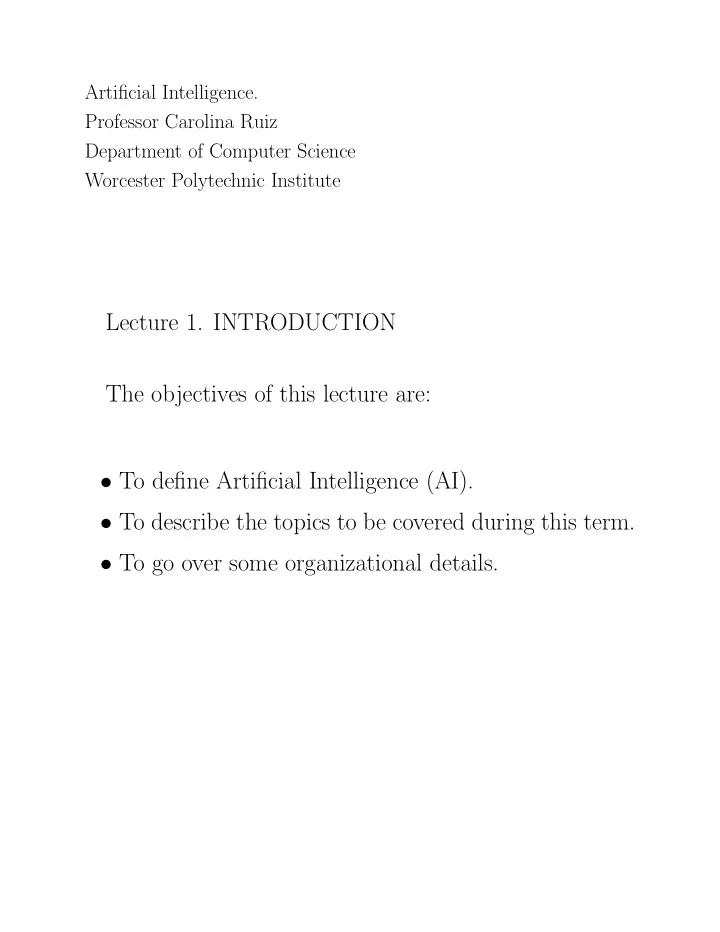

Artificial Intelligence. Professor Carolina Ruiz Department of Computer Science Worcester Polytechnic Institute Lecture 1. INTRODUCTION The objectives of this lecture are: • To define Artificial Intelligence (AI). • To describe the topics to be covered during this term. • To go over some organizational details.
WHAT IS AI? • AI is a relatively new field • It started at the end of the 1940s • Its name was coined by John McCarthy in 1956 • There are many definitions of Artificial Intelligence. Two of them are: – “AI as an attempt to understand intelligent entities and to build them” (Russell and Norvig, 1995) – “AI is the design and study of computer programs that behave intelligently” (Dean, Allen, and Aloi- monos, 1995) • What is an “intelligent entity” or what does it mean to “behave intelligently”? – “Intelligence is the degree of accomplishment ex- hibited by a system when performing a task” (Allen. AAAI97 invited lecture)
OTHER DEFINITIONS OF AI (Adapted from Russell and Norvig’s book) Systems that think like humans Systems that think rationally “The exciting new effort to make computers think . . . machines with “The study of mental faculties minds, in the full and literal sense” through the use of computational (Haugeland, 1985) models” (Charniak and McDer- mott, 1985) “[The automation of] activities that we associate with human “The study of the computations thinking, activities such as that make it possible to perceive, decision-making, problem solving, reason, and act” (Winston, 1992) learning . . . ” (Bellman, 1978) Systems that act like humans Systems that act rationally “A field of study that seeks to ex- plain and emulate intelligent be- havior in terms of computational “The art of creating machines that processes” (Schalkoff, 1990) perform functions that require in- telligence when perfomed by peo- “The branch of computer science ple” (Kurzweil, 1990) that is concerned with the automa- tion of intelligent behavior” (Luger “The study of how to make com- and Stubblefield, 1993) puters do things at which, at the moment, people are better” (Rich “AI is the design and study of com- and Knight, 1991) puter programs that behave intel- ligently” (Dean, Allen, and Aloi- monos, 1995)
THE TURING TEST For the “acting humanly” approach • It was proposed by Alan Turing (1950). • This test is an operational definition of intelligence: It defines intelligent behavior as the ability to achieve human-level performance in all cognitive tasks, suffi- cient to consistently fool human interrogators. • Test: A computer is interrogated by a human through a tty terminal and passes the test if the interrogator cannot tell if there is a computer or a human at the other end. • To pass the Turing test a machine will need to: 1. represent knowledge 2. reason automatically 3. learn 4. process natural language • For the TOTAL Turing test (which includes also a video signal so that the interrogator can test the subject’s perceptual abilities) the machine will also need to: 5 “see” (computer vision) 6 “move” (robotics) There has NOT been a big effort to try to pass the Turing test.
WHAT IS AI? (Cont.) • AI is at the intersection of – philosophy, – mathematics, – psychology, – computer engineering, – linguistics, – cognitive science, and – computer science. • It differs from philosophy and psychology (which are also concerned with intelligence) in which AI strives to BUILD intelligent entities as well as to understand them. • It differs from other subareas of computer science and engineering, in its emphasis on perception, reason, and action.
WHAT IS AI? (Cont.) • AI can be seen as an ensemble of ideas about – representing knowledge – using knowledge to solve problems • with two goals: – Engineering Goal: To solve real-world problems using AI – Scientific Goal: To explain various sorts of intelligence.
TOPICS TO BE COVERED IN THIS COURSE • Core AI: – Knowledge Representation Techniques: Semantic Nets, Rules, Propositional Logic, 1st Order Logic, Probability, . . . – Problem Solving Strategies: Blind Search, Heuristic Search, Optimal Search, Tree and Adversarial Search (Game Playing), Constraint Satisfaction, Logical Inference, Planning, Probabilistic Reasoning, . .. • AI Applications: – Machine Learning, – Machine Vision, and – Natural Language Processing.
SUCCESSFUL STORIES IN AI: • Computer Chess: e.g. Deep Blue, developed at IBM. • Robot Explorers: e.g. Space exploration on Mars. Robot designed at the Jet Propulsion Laboratory. • Autonomous vehicles: e.g. car developed at Carnegie Mellon Univ. • Expert Systems for Medical Diagnosis: e.g. MYCIN (diagnoses blood infections. It performs as well as human experts and considerably better than junior doctors) developed at Stanford Univ. • Expert Systems for Financial Applications. • Language Translation Systems. • Air Traffic Control Systems • Automated Personal Assistants • Robots for Hazardous Conditions
Recommend
More recommend